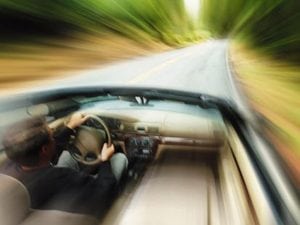The rights and duties of motorists regarding the speed of their vehicles is largely defined in Md. Transp. Code Ann. §21-801.1-speeding cause accident.
The Maryland legislature has established maximum speed limits as follows:
- 30 miles an hour on all highways in a business district and undivided highways in a residential district;
- 35 miles an hour on divided highways in a residential district;
- 50 miles an hour on undivided highways in other locations;
- 55 miles an hour on divided highways in other locations;2 and
- 65 miles an hour on an interstate highway or expressway
The basic rule regulating the proper speed at which motorists may drive is contained in Transp. §21-801. Rather than simply mandate that a motorist may not exceed the posted speed limit, the statute provides that “a person may not drive a vehicle on a highway at a speed that, with regard to the actual and potential dangers existing, is more than that which is reasonable and prudent under the conditions.” It is additionally provided that “[a]t all times, the driver . . . shall control the speed of the vehicle as necessary to avoid colliding with any person or any vehicle or other conveyance that, in compliance with legal requirements and the duty of all persons to use due care, is on or entering the highway.”
A motorist may be considered to be proceeding at an “excessive” rate of speed even when he is travelling within the posted speed limit depending on the circumstances. Where there are no special circumstances, the court will find the posted speed limit to be a reasonable and proper.
Thus, even if a motorist is proceeding within the posted speed limit, he or she may be found negligent for exceeding a safe speed, particularly where conditions or hazards are present requiring the reduction of speed. If a driver’s view is obstructed by smoke, fog, rain, snow, sleet, or other atmospheric conditions, he or she must exercise care to avoid injury including reducing speed. A motorist can be negligent driving 20 miles below the speed limit through drifting snow that completely obliterated his view, motorist faced with the glare of headlights of an approaching car.
Md. TRANSPORTATION Code Ann. § 21-804 Minimum speed regulation (a) Slow speed impeding traffic prohibited. — Unless reduced speed is necessary for the safe operation of the vehicle or otherwise is in compliance with law, a person may not willfully drive a motor vehicle at such a slow speed as to impede the normal and reasonable movement of traffic.
The Maryland Motor Vehicle Code prohibits a person from driving a vehicle in a race or speed contest on any highway or on any private property that is used by the public in genera1. Md. Transp. Code Ann. §21-1116.
It is well settled in Maryland that the racing of motor vehicles on a public highway is negligence and that both vehicles will be found liable even if only one of the vehicles struck the innocent car.
Speeding alone is not enough to prove the speeding driver is at fault. Often a potential client will present a case where they were making a left- hand turn in front of a vehicle and a collision occurs. The client will then suggest the accident is the fault of the other driver because they were speeding. This defense is unlikely to work because of one of the following reasons:
- Client must be negligence free. If client saw the defendant speeding, then, client should not have made the left- hand turn. More likely than not client does not know how fast the other car was going and assumed he must be speeding because client could not possibly have made a mistake.
- Client says he never saw the other car therefore, the car must have been speeding. If he never saw the car, then the court will not let he testify that the car he never saw was speeding.
- Exceeding the speed limit does not constitute actionable negligence unless it is the proximate cause of injury.” Thus, the mere showing of excessive speed on the part of the driver is not enough to support an action in negligence. There must be a further showing that the excessive speed was a direct and proximate cause of the injury. In Spence v. Wiles,32 a child suddenly darted in front of a car in the middle of a block. The court noted that there was only speculation that the driver was speeding. It further commented that “[t]c) show merely excessive speed is ordinarily not enough to support an inference of negligence unless there is some further showing that this excessive speed is a direct and proximate cause of the injury.” In Alston v. Forsythe,35 the court found that even if the driver had been travelling within the legal limit, he would not have been able to stop in time to avoid hitting a child. Thus, the court found that speed was not a proximate cause of the injury.
- Bottom line-Even if you can prove the other car was speeding, you will need an expert to testify that if the car was not speeding, then the accident would not have happened. Often clients present a case where the pedestrian or another car pull in front of them at the last second. Most of the time, in that situation, it does not matter how fast the driver was going because no matter what the speed, he would not have been able to avoid the accident. Therefore, speed was not the cause of the accident and therefore the speeding driver will not be a cause of the accident.
Proving speeding can often be difficult in an accident case. There are several ways to prove speed.
- Use of radar- Very rarely will someone be aiming a radar gun at a speeding vehicle when an accident takes place
- Use of speedometer- Victim or another vehicle may be able to judge speed of offending vehicle using their own speedometer immediately before the accident
- If you are an experienced driver, Maryland rules of evidence allow you to estimate the speed of vehicles. This is a very in exact way to do so and is also very self- serving but the courts continue to allow this type of testimony.
- Circumstantial evidence is permitted.
- testimony of the existence and length of skid-marks or tire-marks has often been admitted to show excessive speed. All that is required is a sufficient showing, either from the time of the observation, from the relative locations of the marks and the car, or from other convincing facts, to support a reasonable inference that the vehicle in question made the marks. The fact of skidding alone is not, however, sufficient to take the case to the jury on the issue of speed.
- Other circumstantial evidence permitting an inference of speed is testimony that the brakes were applied too late or that the car did not stop until it had gone an extraordinary distance after the brakes were applied. Additionally, evidence as to the distance within which a car could be stopped is admissible to aid in determining excessive speed. In this regard, it should be noted that an individual with practical experience with automobiles who can express an opinion as to the distance within which a specified automobile, moving at a specified speed and under specified conditions, could be stopped will be permitted to express an opinion; the witness need not be an “expert” as such.43 Factors that must be taken into account by the witness include the condition of the vehicle’s tires, the grade of the road, and the condition of the surface of the road.
- Hire an accident reconstruction expert who is trained in determine speed and causation in an accident based upon many factors.
If a passenger is in a vehicle that the passenger knows is speeding, and fails to object or ask to get out of the vehicle, the passenger may be found to be contributorily negligent. It would be unreasonable to hold that a passenger in an automobile, who knew that it was being driven at a speed so excessive as to endanger the lives of persons in the lawful use of the public highways of the State as well as the occupants of the machine, and who so far acquiesced in, approved, and participated in the conduct of the driver, that he made no protest or objection to it when he could, was guilty of negligence directly contributing to the injury complained of.
If he knew that the speed at which the car was being driven was so great as to imperil the lives and safety of its occupants, it was his plain duty to have warned the driver and to have protested against the speed of the machine, and if he failed to perform that duty when it was within his power to perform it, and the accident which he knew might happen actually did happen, then he is considered equally negligent and will not be able to sue the driver..
For more info on car accidents in Maryland CLICK HERE.






